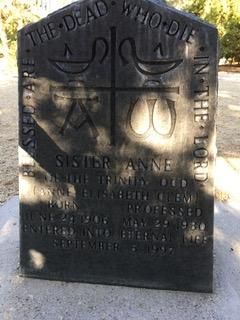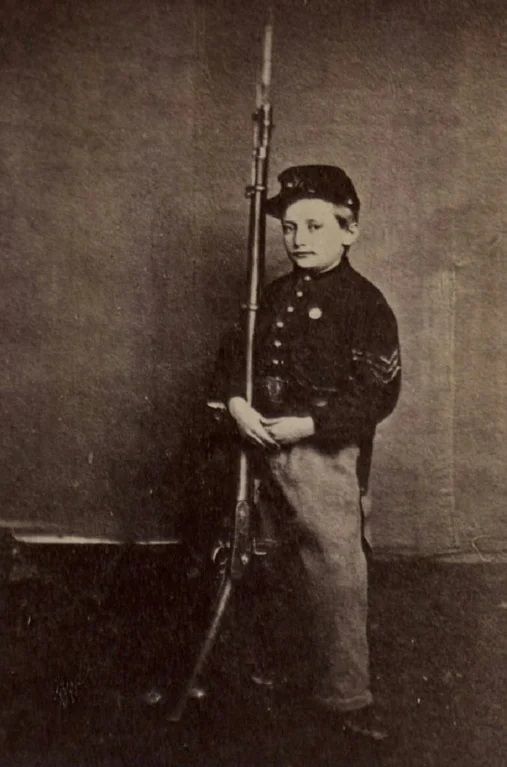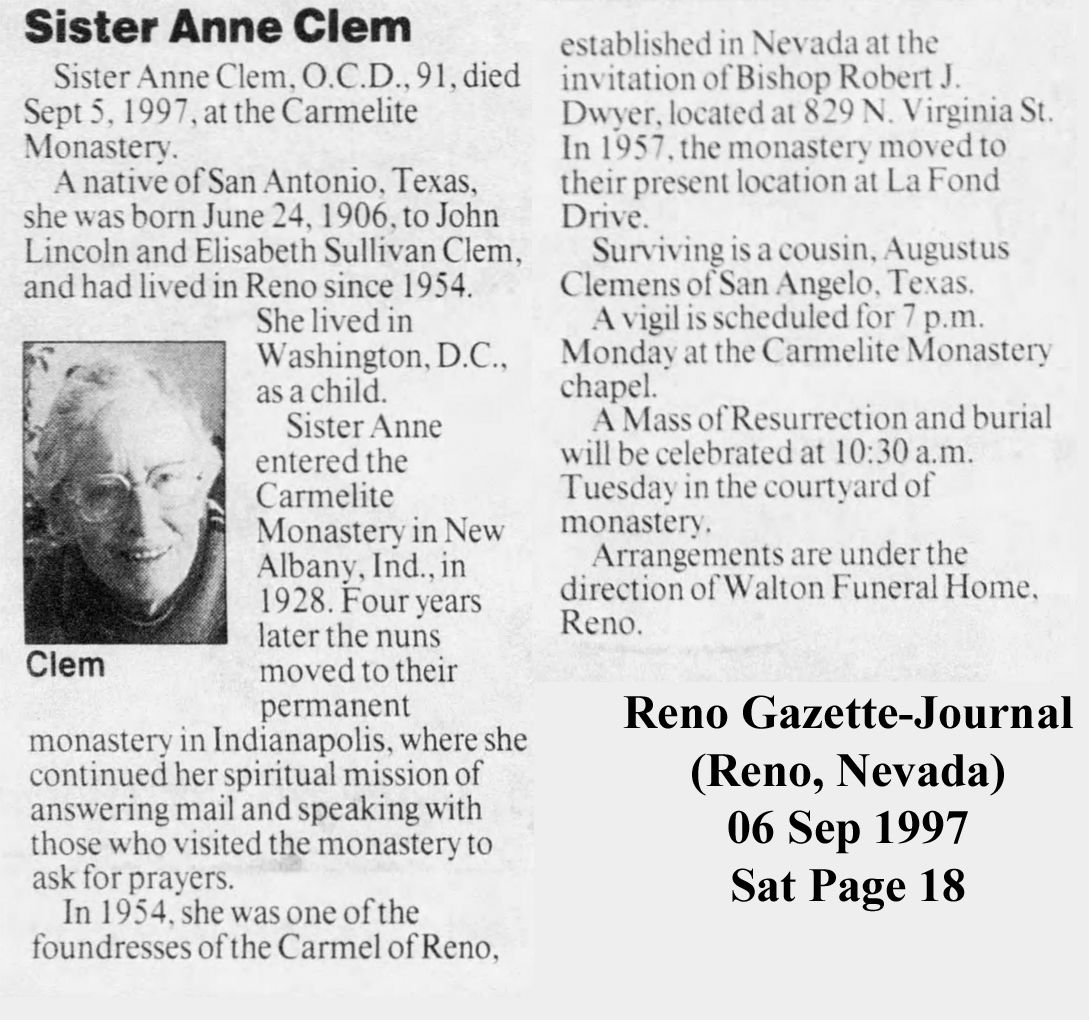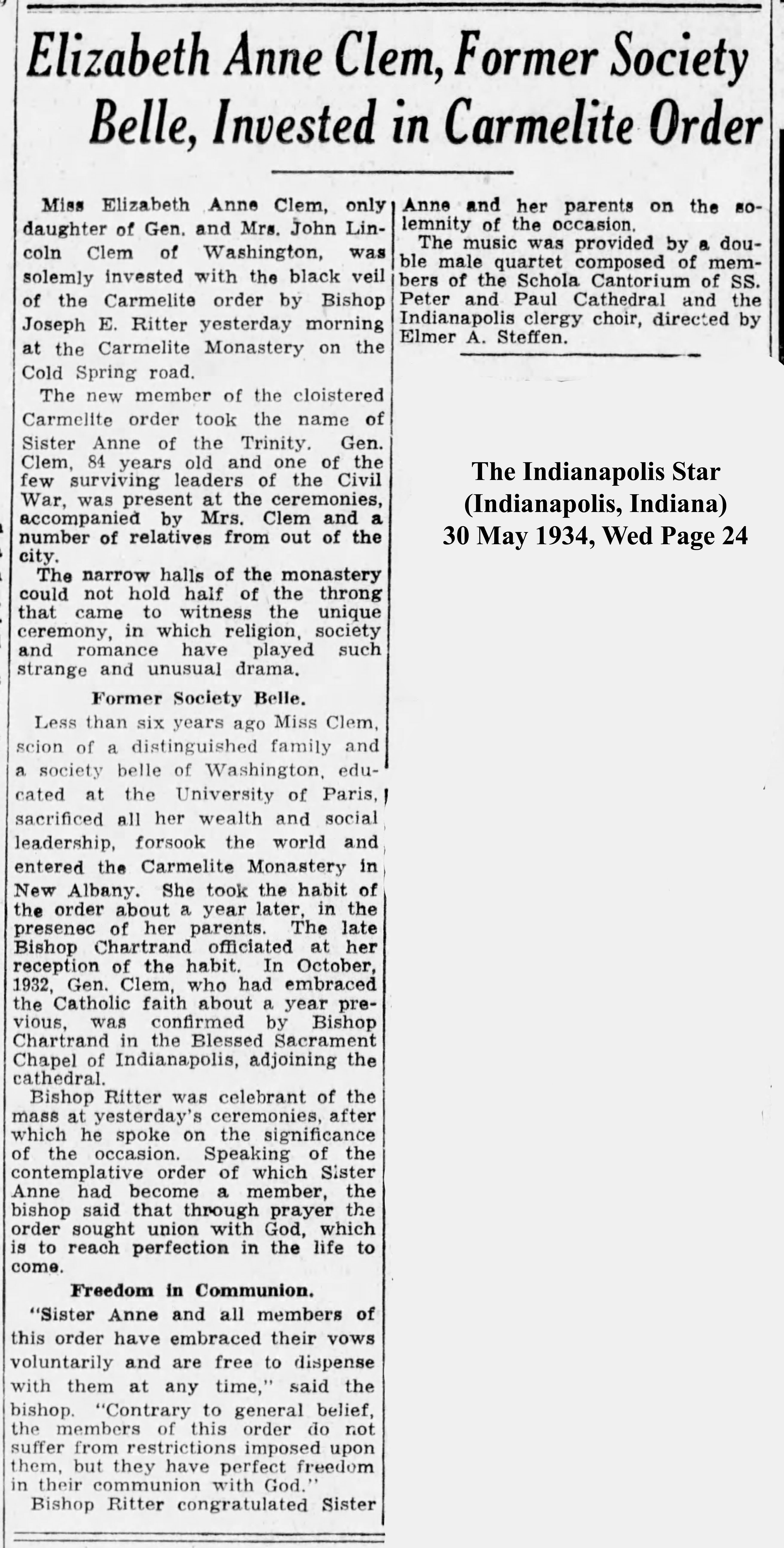At the time of her mothers death in 1967, Sister Anne of the Trinity OCD was the Mother Superior of Carmel of Reno.
Carmelite Monastery, Reno
In August, 1954, eight nuns from a strictly cloistered Carmelite monastery in Indianapolis accepted an invitation from Nevada bishop, Robert J. Dwyer, to establish a foundation in Reno . It has since been embraced by people of all religious persuasions, who request the nuns' prayers and contribute to their financial support. The Carmel of Reno has a rich heritage. Teresa of Avila, Spain, founded the first reformed Discalced (barefoot) Carmelite monastery for women in 1562. One of her collaborators in the restructuring of the Carmelite Order was the mystic, John of the Cross, a founding member of the men's reformed branch of the Order. Both groups followed a rule of life given by the Patriarch of Jerusalem in the thirteenth century to hermits living on nearby Mt. Carmel. The Discalced Carmelite movement spread throughout Europe. The first women's Carmel in the United States was at Port Tobacco, Maryland in 1790. By 1954, the Carmelite nuns had more than sixty monasteries nationwide. According to their regulations, each monastery was limited in size to twenty-one nuns. Because the Indianapolis monastery had reached its quota, eight members were chosen to establish a Carmel in Reno, which was considered by Church officials at the time to be "missionary territory." The Reno Dominican sisters at Saint Mary's Hospital provided lodging to the Carmelites until they found temporary quarters at 829 North Virginia Street. In 1958 the group moved to a new permanent monastery in the Sierra Nevada foothills of Washoe County, southwest of the city. At the time, it was surrounded only by empty desert, but now the monastic enclosure of eight acres is a unique island of quietness inside the Reno city limits. The monastery includes living and dining facilities, secluded areas for private retreats, a small cemetery, and a new (2001) stunningly modern chapel made possible by local grants and donations. Besides the usual daily housework and gardening, the Carmelites have another occupation that provides them with a modest source of income. When they first came to Reno, they baked altar breads and created liturgical vestments. Now they design and print Christmas and greeting cards, which are in demand across the United States. Until the 1960s, the Carmelite women observed customs that were common in sixteenth century Spain. Their rigorous lifestyle included virtually no contact with personnel outside the monastery. A grill and head veil separated them from the view of family and other visitors, reflecting the medieval notion that women were to be protected. Their beds were straw, their food did not include meat, and, as now, they gathered regularly during the day and night to pray. Their religious garb (habit) was nearly identical to the rough brown peasant dress of the sixteenth century. Today, the eighteen nuns at Carmel of Reno wear contemporary dress and attend educational and cultural events outside the enclosure. In addition, their liturgical celebrations are open to the public. Every few years, they elect from their ranks a prioress, who, in consultation with all the nuns, oversees the administration of the monastery. Although the nuns' lifestyle has been modernized based on guidelines established by the Second Vatican Council, the group's primary purpose continues to reflect the inspiration of Teresa of Avila. It is to live a life of prayer, while remaining informed and aware of the world's needs and its people.
At the time of her mothers death in 1967, Sister Anne of the Trinity OCD was the Mother Superior of Carmel of Reno.
Carmelite Monastery, Reno
In August, 1954, eight nuns from a strictly cloistered Carmelite monastery in Indianapolis accepted an invitation from Nevada bishop, Robert J. Dwyer, to establish a foundation in Reno . It has since been embraced by people of all religious persuasions, who request the nuns' prayers and contribute to their financial support. The Carmel of Reno has a rich heritage. Teresa of Avila, Spain, founded the first reformed Discalced (barefoot) Carmelite monastery for women in 1562. One of her collaborators in the restructuring of the Carmelite Order was the mystic, John of the Cross, a founding member of the men's reformed branch of the Order. Both groups followed a rule of life given by the Patriarch of Jerusalem in the thirteenth century to hermits living on nearby Mt. Carmel. The Discalced Carmelite movement spread throughout Europe. The first women's Carmel in the United States was at Port Tobacco, Maryland in 1790. By 1954, the Carmelite nuns had more than sixty monasteries nationwide. According to their regulations, each monastery was limited in size to twenty-one nuns. Because the Indianapolis monastery had reached its quota, eight members were chosen to establish a Carmel in Reno, which was considered by Church officials at the time to be "missionary territory." The Reno Dominican sisters at Saint Mary's Hospital provided lodging to the Carmelites until they found temporary quarters at 829 North Virginia Street. In 1958 the group moved to a new permanent monastery in the Sierra Nevada foothills of Washoe County, southwest of the city. At the time, it was surrounded only by empty desert, but now the monastic enclosure of eight acres is a unique island of quietness inside the Reno city limits. The monastery includes living and dining facilities, secluded areas for private retreats, a small cemetery, and a new (2001) stunningly modern chapel made possible by local grants and donations. Besides the usual daily housework and gardening, the Carmelites have another occupation that provides them with a modest source of income. When they first came to Reno, they baked altar breads and created liturgical vestments. Now they design and print Christmas and greeting cards, which are in demand across the United States. Until the 1960s, the Carmelite women observed customs that were common in sixteenth century Spain. Their rigorous lifestyle included virtually no contact with personnel outside the monastery. A grill and head veil separated them from the view of family and other visitors, reflecting the medieval notion that women were to be protected. Their beds were straw, their food did not include meat, and, as now, they gathered regularly during the day and night to pray. Their religious garb (habit) was nearly identical to the rough brown peasant dress of the sixteenth century. Today, the eighteen nuns at Carmel of Reno wear contemporary dress and attend educational and cultural events outside the enclosure. In addition, their liturgical celebrations are open to the public. Every few years, they elect from their ranks a prioress, who, in consultation with all the nuns, oversees the administration of the monastery. Although the nuns' lifestyle has been modernized based on guidelines established by the Second Vatican Council, the group's primary purpose continues to reflect the inspiration of Teresa of Avila. It is to live a life of prayer, while remaining informed and aware of the world's needs and its people.
Gravesite Details
It is believed that Sister Anne is buried at Carmel of Reno.
Family Members
Sponsored by Ancestry
Advertisement
Advertisement
















